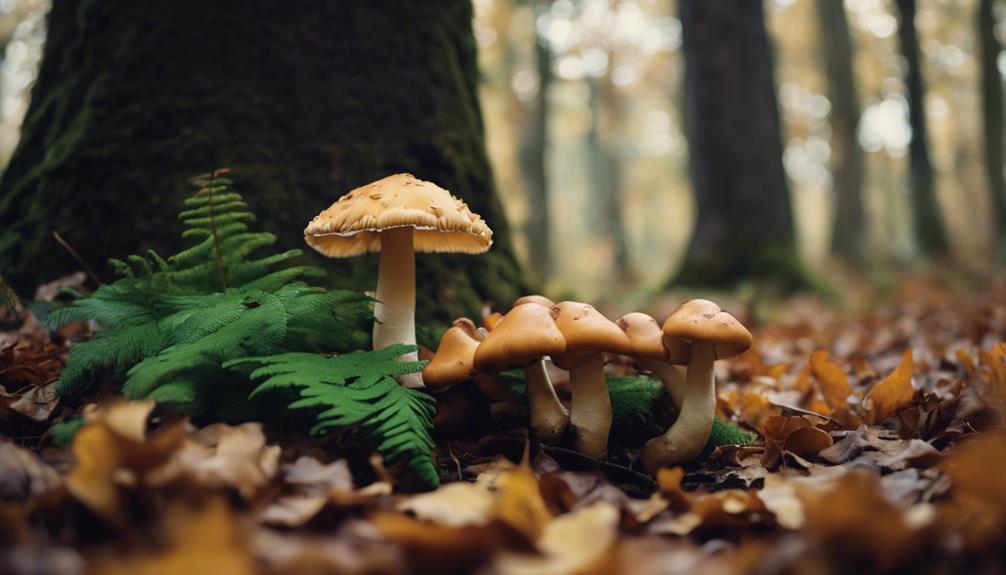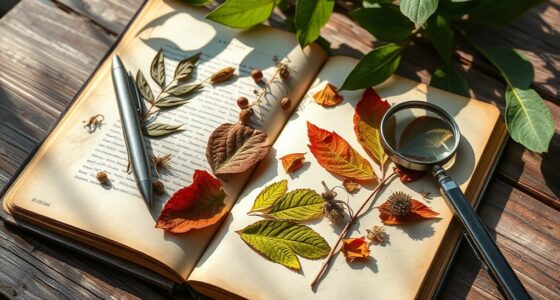You're about to uncover the secret ingredients that make Cajun cuisine truly unforgettable: the wild herbs and plants of Louisiana's bayous and swamps. Get ready to forage for mountain mint, pepper grass, and wild garlic, which add unique flavors and medicinal properties to traditional dishes. From chanterelle mushrooms to muscadine grapes, the Bayou State is a treasure trove of wild edibles. Discover how foraging for these ingredients promotes sustainability and connects you with local heritage. As you explore the wilds of Louisiana, you'll uncover the authentic flavors that make Cajun cuisine so renowned – and get ready to elevate your cooking to the next level.
Key Takeaways
- Foraging for wild herbs like mountain mint, pepper grass, and elderberry adds unique flavors and medicinal properties to traditional Cajun dishes.
- Mulberries, elderberry, and wild plums provide fresh and unique flavors, enhancing the authenticity of Cajun cuisine.
- Chanterelles, Old Man of the Woods, and Oyster mushrooms are prized edible mushrooms in Louisiana, requiring proper identification to avoid toxic lookalikes.
- Edible wildflowers like violets, daylilies, and dandelions offer medicinal and culinary benefits, supporting the local ecosystem.
- Foraging promotes sustainability by utilizing natural resources, connecting with local heritage, and enjoying traditional Cajun flavors and dishes.
Wild Herbs of the Bayou
As you venture into the heart of the Bayou, you'll discover a treasure trove of wild herbs waiting to be foraged, including mountain mint, pepper grass, and elderberry, which have been woven into the fabric of Cajun cuisine for generations. These plants have been an integral part of the region's culinary heritage, providing unique flavors and medicinal properties to traditional dishes.
Mountain mint, with its antimicrobial benefits, adds a revitalizing twist to classic Cajun recipes. Elderberry, rich in antioxidants and vitamins, brings a burst of flavor and nutrition to local dishes. By incorporating these wild herbs into traditional Cajun cuisine, you'll not only enhance the authenticity of the dishes but also connect with the region's biodiversity and rich cultural heritage.
As you explore the Bayou, keep an eye out for these wild herbs, and get ready to elevate your culinary game with the flavors of Louisiana's edible wilds.
Foraging for Fresh Flavors

Your Louisiana adventure takes a flavorful turn as you forage for fresh flavors in the Bayou's untamed landscape. As you venture into the wild, you'll discover a world of edible delights waiting to be uncovered. Foraging in Louisiana offers access to fresh and unique flavors from edible wild plants, allowing you to experience the rich culinary heritage of the region.
| Wild Edible | Flavor Profile | Culinary Use |
|---|---|---|
| Groundnut | Nutty, earthy | Soups, stews, and salads |
| Mountain Mint | Cool, invigorating | Teas, cocktails, and desserts |
| Elderberry | Sweet, fruity | Jams, preserves, and sauces |
As you explore the Bayou's wild edibles, you'll discover that traditional ingredients like mulberries, elderberry, and groundnut are commonly foraged in Louisiana. These wild edibles add a depth of flavor and authenticity to your Cajun feast. By foraging for fresh flavors, you're not only connecting with the local heritage but also promoting sustainability by utilizing natural resources. So, get ready to indulge in a culinary adventure that will leave you wanting more of Louisiana's wild flavors!
Native Plants in Cajun Cuisine

You'll find that native plants are an integral part of Cajun cuisine, adding authenticity and depth to traditional dishes.
These plants, often foraged from Louisiana's edible wilds, bring unique flavors and textures to the table. Many of these foraged ingredients carry a rich history of traditional use in Southern cuisine, enhancing dishes with bold, earthy notes. Just as the wild foods of Oklahoma provide a culinary connection to the region’s indigenous practices, Louisiana’s edible plants tell a story of the land and its people. Whether in a hearty gumbo or a fresh salad, these wild finds offer a true taste of place.
Sassafras, filé powder, and wild onions are staples in many Cajun recipes, adding a touch of authenticity to gumbos, soups, and stews. Other native plants like water hyacinth, Spanish moss, and Louisiana iris are also used to create distinct flavors and presentation.
When foraging for Cajun ingredients, you might stumble upon wild garlic, cattails, or wild plums, which can add a unique twist to traditional recipes. Local herbs like thyme, oregano, and bay leaves are also commonly used to enhance flavors.
Even oyster mushrooms, often found in Louisiana's forests, can be used to add an earthy flavor to dishes.
Mushroom Hunting in Louisiana

As you venture into Louisiana's woods, you're likely wondering what types of edible mushrooms you can find and how to safely forage for them.
You'll want to learn about the different varieties, like chanterelles, and what common lookalikes to avoid to guarantee a safe and successful hunt.
Types of Edible Mushrooms
Among Louisiana's diverse wild mushroom species, the highly prized chanterelle is a coveted find for foragers and chefs alike. You might stumble upon smooth chanterelles, which closely resemble the true chanterelle species. These golden-hued mushrooms are particularly sought after for their fruity, apricot-like aroma and peach-colored flesh.
When you're out foraging in oak and hardwood forests after rains, keep an eye out for the Old Man of the Woods, a type of edible mushroom that's a favorite among locals. As a forager, you'll have the opportunity to enhance your Cajun dishes with these flavorful wild mushrooms.
Local mushroom hunters like Logan Wiedenfeld have self-taught themselves the techniques to locate and identify edible mushroom species. By doing so, they're able to uncover the hidden gems of Louisiana's forests, bringing these wild delicacies to the table. With practice and patience, you can do the same, discovering the rich flavors and textures of Louisiana's edible mushrooms.
Safe Foraging Practices
When foraging for wild mushrooms in Louisiana, identifying the right species is only half the battle – knowing how to forage safely is just as important. As you venture into the bayous and forests, keep in mind that proper identification and caution are essential to avoid potential risks.
| Safety Tips | Why It Matters | Best Practices |
|---|---|---|
| Seek guidance from experienced foragers or mycologists | Ensure accurate identification and avoid misidentification | Research and consult with experts before heading out |
| Exercise caution when handling mushrooms | Avoid contamination and allergic reactions | Wear gloves and wash hands thoroughly after handling |
| Forage in areas with minimal human impact | Reduce risk of contamination and pollution | Avoid areas with heavy foot traffic or industrial activity |
| Follow local regulations and guidelines | Respect the environment and avoid over-harvesting | Check with local authorities for any regulations or restrictions |
Common Lookalikes to Avoid
While exploring Louisiana's woods, you'll need to steer clear of certain mushrooms that can masquerade as edible varieties, yet pose a serious threat to your health.
When mushroom hunting in Louisiana, it's important to be aware of common lookalikes that can be mistaken for edible species. The deadly Amanita species, for instance, can be easily confused with edible mushrooms, but can cause severe illness or even death if consumed.
Another dangerous lookalike is the False Morel (Gyromitra species), which can cause vomiting, diarrhea, and abdominal cramps if ingested.
Inexperienced foragers should also be cautious of the Destroying Angel (Amanita bisporigera), a highly toxic mushroom that resembles edible varieties.
Additionally, the Jack-o'-Lantern mushroom (Omphalotus illudens) is often mistaken for chanterelles but is poisonous and should be avoided.
Accurate identification is key to preventing accidental poisoning and ensuring a safe foraging experience.
Always exercise extreme caution when mushroom hunting in Louisiana, and never consume a mushroom that you're not absolutely sure is safe.
Wild Fruits of the South

Venture into Louisiana's forests, swamps, and riverbanks, and you'll discover a treasure trove of wild fruits, including muscadine grapes, pawpaws, and mayhaws, that are ripe for the picking. These native plants are a staple in traditional Cajun cuisine, and for good reason.
Muscadine grapes, with their thick skins and sweet, musky flavor, are a favorite among locals. Pawpaws, on the other hand, boast a unique flavor profile that's reminiscent of a mix of banana and mango, making them a highly sought-after wild fruit in the South.
As you forage for these wild fruits, keep in mind that they grow in abundance in Louisiana's forests, swamps, and along riverbanks. Mayhaws, with their tart flavor, are often used to make jams and jellies, while pawpaws are perfect for snacking or adding to desserts. Muscadine grapes, with their rich flavor, are great for making wine or simply enjoying fresh off the vine.
Cajun Cooking With Wild Greens

As you explore the world of Cajun cooking with wild greens, you'll discover the versatility of these edible treasures.
From adding a burst of flavor to traditional dishes to providing medicinal properties, wild greens like sow thistle and milk thistle take center stage.
Now, let's take a closer look at the Wild Edibles Primer, Gumbo's Secret Ingredient, and Wild Spinach Delights that will elevate your Cajun cuisine.
Wild Edibles Primer
You'll find that Cajun cooking often relies on incorporating wild greens like sow thistle and curly dock leaves to add unique flavors and depth to traditional dishes. As you explore the world of wild edibles, you'll discover a diverse range of ingredients to elevate your Cajun feast.
Charles Allen, a renowned forager, emphasizes the importance of understanding the region's rich biodiversity, which offers a plethora of edible plants. These wild edibles not only enhance the culinary experience with local flavors but also reflect a deep connection to the land and traditions of the region.
Foraging for wild edibles in Louisiana can lead to discovering hidden gems like milk thistle, sumac, and horsetail. These plants can be utilized in Cajun recipes to add depth and nutrition. By incorporating wild edibles into your cooking, you'll be able to create authentic, flavorful dishes that showcase the region's unique character.
Gumbo's Secret Ingredient
When cooking up a pot of gumbo, don't be surprised if a pinch of wild greens like sow thistle or curly dock leaves is the secret ingredient that takes your dish from good to great.
In Cajun cooking, incorporating wild greens is a traditional practice that adds depth and complexity to the classic dish. You're not just adding a handful of weeds to your pot; you're tapping into the rich cultural heritage of Louisiana's Acadian people.
By foraging for wild greens, you're connecting with the land and honoring the traditions of your ancestors. And let's not forget the flavor – wild greens like sow thistle and curly dock bring a unique bitterness that balances out the richness of the gumbo.
Wild Spinach Delights
Discover the rich flavor and nutritional benefits of wild spinach, a staple in traditional Cajun cuisine, and learn how to incorporate this versatile green into your favorite dishes. As you forage for wild spinach, also known as lamb's quarters, you'll not only get a free source of fresh greens but also a dose of vitamins A and C, calcium, and iron.
Here are three ways to get started with wild spinach in your Cajun cooking:
- Add it to gumbo: Wild spinach pairs perfectly with the rich flavors of gumbo, adding a burst of freshness to this classic Cajun dish.
- Use it in jambalaya: Mix cooked wild spinach into your jambalaya for a nutritious twist on this one-pot wonder.
- Make an étouffée: Wild spinach is a natural fit for this spicy stew, adding depth and complexity to the dish.
When foraging for wild spinach, look for diamond-shaped leaves with a powdery coating. With its abundance in Louisiana's natural landscapes, you'll have no problem finding this nutritious green to elevate your Cajun cooking.
Edible Wildflowers of Louisiana

What's surprising is that Louisiana's diverse ecosystems are teeming with edible wildflowers, waiting to be foraged and added to your next culinary creation. As you explore the state's wilds, you'll discover a variety of edible plants, including violets, daylilies, and elderflowers. These edible wildflowers can be used to add unique flavors and textures to your dishes, making them a great addition to your next meal.
You'll find honeysuckle, dandelions, and clover growing abundantly in Louisiana's fields and forests. Some wildflowers, like chicory, hibiscus, and passionflower, offer both medicinal and culinary benefits. Foraging for edible wildflowers in Louisiana provides a connection to nature and local biodiversity. By incorporating these wildflowers into your cooking, you'll not only add flavor and variety to your meals, but you'll also be supporting the local ecosystem.
Wild Delicacies of the Swamp

Venturing into Louisiana's swampy territories, you'll uncover a domain of wild delicacies that'll elevate your culinary adventures. The diverse landscape of Louisiana's swamps offers a variety of edible plants and mushrooms for exploring, making it a haven for culinary explorers.
As you explore further into the swamp, you'll discover unique ingredients that'll transport your taste buds to the heart of Cajun country.
Here are some of the wild delicacies you might stumble upon:
- Crawfish: A staple in New Orleans cuisine, crawfish add a burst of flavor to any dish.
- Alligator: This exotic meat is often used in traditional Cajun feasts, adding a touch of adventure to your plate.
- Wild game: From deer to wild boar, the swamps of Louisiana are home to a variety of wild game that'll add a touch of the wild to your culinary creations.
Frequently Asked Questions
What Are 3 Edible Native Plants in Louisiana?
You're looking for edible native plants in Louisiana! You'll find three tasty options: wild plums with their sweet-tangy taste, sow thistle as a nutritious green, and milk thistle with its healing properties and culinary uses.
What Wild Berries Grow in Louisiana?
As you venture into the wild, you're like a kid in a candy store, discovering Louisiana's sweet treasures! You'll find an abundance of wild berries, including mulberries, blackberries, dewberries, and elderberries, ripe for the picking in forests, fields, and along waterways.
What Fruit Is Native to Louisiana?
You're looking for fruits native to Louisiana! You'll be delighted to know that the Chickasaw Plum, a sweet and tangy fruit, is native to the state, offering a unique flavor to your culinary creations.
What Flowers Are Edible in Louisiana?
As you wander through Louisiana's lush landscape, you'll discover a bouquet of edible flowers, like honeysuckle, violets, and daylilies, that'll add a pop of color and flavor to your dishes, allowing you to savor the sweetness of the Pelican State.
Conclusion
As you venture into Louisiana's wilds, the flavors of the bayou await. With each foraged find, the Cajun feast takes shape. Wild herbs and mushrooms, native plants and fruits, all blend together in a culinary celebration.
The swamp's secrets are yours to uncover, and with every bite, the magic of the wild is savored. So, savor the adventure, and let the flavors of Louisiana's edible wilds leave you wanting more.










